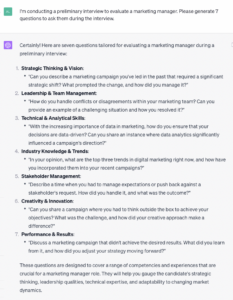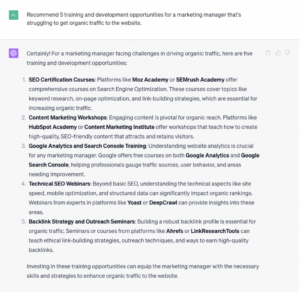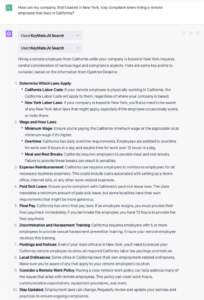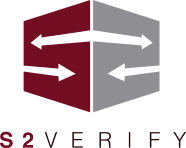How HR Professionals Can Leverage ChatGPT (With Sample Prompts)
Artificial intelligence has been transforming human resources departments and how they operate for years. AI, an area of computer science that focuses on the creation of intelligent machines that work and behave like humans, has been touted by tech greats (like Bill Gates) as a development as groundbreaking as the Internet or cell phones. And, with a proven ability to streamline processes, provide insightful analytics, and enhance talent acquisition, AI is a force that HR leaders can no longer ignore.
And they aren’t.
A recent study found that the majority of the 250 HR leaders surveyed said they are already using AI across HR functions like employee records management (78%), payroll processing and benefits administration (77%), recruitment and hiring (73%), performance management (72%), and onboarding new employees (69%).
Enter: Generative AI
Now, with the development of generative AI, particularly popular ChatGPT, a state-of-the-art conversational AI developed by OpenAI, artificial intelligence is expanding its reach even further.
With its ability to understand and generate human-like text, and its ability to be customized with a certain (industry-specific, company-specific, or department-specific) data set, ChatGPT offers expanded opportunities for HR professionals to optimize their operations, enhance employee experiences, and open up more time for strategic work.
In the future, AI may even be able to perform sensitive HR tasks like hiring and firing employees, as well as answering HR-related employee queries and negotiating salary details. In fact, experts predict that by 2024 80% of global 2000 companies will use AI-powered “managers” to hire, fire and train employees.
Generative AI is expected to reorient entire industries like this, a phenomenon that is already in process—leaving massive opportunities for early adopters and first-movers and opening the door for increased risk for companies that resist the change.
It’s time to hop on the generative AI bandwagon. Below are the three primary ways HR departments can start using it today to unlock new opportunities and efficiencies and prepare for a future with AI.
Recruiting, Simplified
Recruiting involves several repetitive, tedious tasks that eat up a hiring professional’s time. Thankfully, generative AI can automate these repetitive tasks so recruiters can focus on what matters most: designing a more effective recruiting program that attracts top talent and reduces hiring risk.
HR professionals can hand off tasks such as screening resumes, scheduling interviews, writing job descriptions, coming up with search keywords that target qualified candidates, and generating interview questions for ChatGPT.
On that last note, here’s an example prompt and real-life ChatGPT response for generating interview questions for a marketing manager position:

Even if the ChatGPT-generated results aren’t optimal for the specific use case, outputs give recruiters a starting point from which they can customize and hone, ultimately cutting down on the time it takes to prepare for an interview (or another repetitive task).
In addition to automating repetitive tasks, generative AI can assist with candidate engagement during the recruiting process by providing real-time support and answering frequently asked questions about the organization or the application process.
The Employee Experience, Optimized
Today, preventing turnover and improving retention represent some of the most important responsibilities of the modern HR department. HR leaders focus on streamlining every step of the employee lifecycle—generative AI can help them do that.
Onboarding
Twenty percent of employee turnover happens within the first 45 days. What’s more? 69% of employees are more likely to stay with a company for three years if they experience a great onboarding process.
HR teams can configure ChatGPT to provide real-time support and direction to new hires, including automated delivery of training materials and resources. That training can include interactive learning modules that make the learning process more dynamic and life-like.
Plus, rather than taking up valuable HR time, new employees can turn to ChatGPT for personalized help on company policies, procedures, benefits, paperwork, and more questions.
Generative AI can also cut down on time-consuming administrative tasks, like scheduling orientation sessions or drafting reminders to new hires about required paperwork.
Performance Management
Managers can input feedback from which ChatGPT can create action plans, help employees set goals, suggest tailored improvement plans, streamline performance reviews, and recommend training opportunities based on areas that need improvement—promoting constructive feedback, effective goal-setting, and personalized development, leading to improved employee performance and engagement.
Here’s an example prompt for leveraging ChatGPT (particularly ChatGPT-4, which can be plugged into the internet) to point employees in the direction of the right professional development courses:

Training
On that note, generative AI functions really great across the entire employee lifecycle as a learning and development tool. In lieu of traditional training materials, HR professionals can use ChatGPT to create interactive modules with which new employees can engage in a dialogue, asking questions and receiving immediate feedback, making the learning process more dynamic.
Generative AI could also be integrated into collaborative platforms to facilitate group discussions and peer learning, encouraging employees to share knowledge and best practices while fostering a sense of community and engagement.
Engagement and Feedback
When it comes to employee engagement that goes beyond learning and development, generative AI can be used to collect feedback from employees anonymously, giving them a space to voice their concerns, make suggestions, and offer feedback without fear of retribution—leading to more honest insights and helping HR professionals address issues proactively.
Additionally, with burnout on the rise, HR can deploy generative AI to conduct regular check-ins with employees, asking about their well-being and offering resources or support if needed.
HR Support
In place of a traditional ticketing system, HR departments can use generative AI to offer 24/7 support to employees. Whether it’s questions about leave policies, benefits, or any other HR-related query, the AI can provide instant answers, reducing the workload on HR professionals and increasing employee satisfaction.
Generative AI can also be integrated with the company’s internal systems to retrieve employee documents or information. For example, if an employee needs a copy of their employment contract, they can simply ask the AI, which will fetch the document in real time.
Compliance, Made Easy
Compliance is one of the most complicated (and ongoing) HR responsibilities today, especially with employment laws and regulations changing regularly. Compliance involves many small, tedious, time-intensive steps but demands an informed and strategic approach from HR leaders. As such, more and more HR professionals are turning to ChatGPT to manage nitty gritty compliance tasks so they can focus on a high-level compliance strategy that protects the business from all angles.
For example, ChatGPT can be programmed to stay updated with the latest HR-related legislation and policies, providing real-time information to HR personnel and ensuring they always follow the latest regulations. It can scan employment contracts, company policies, or other HR documents to identify any non-compliant terms or clauses based on the most up-to-date laws and can provide employees with accurate and compliant information when they ChatGPT as a 24/7 HR assistant.
HR employees can access interactive training on compliance and get instant answers to their compliance-related questions as they perform their normal duties. Here is an example prompt that an HR employee could use to guide their work and remain compliant:

Generative AI can also assist HR departments in preparing for audits by providing necessary compliance reports and documentation and can provide insights into areas where the department might be at risk of non-compliance.







